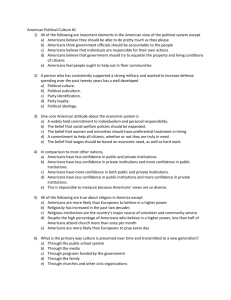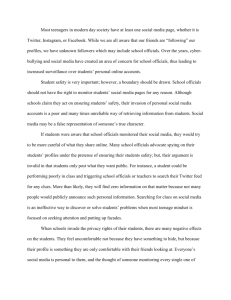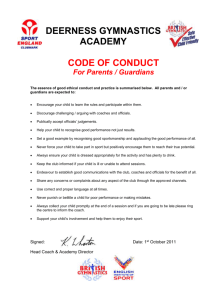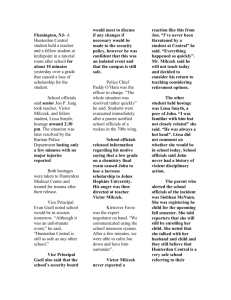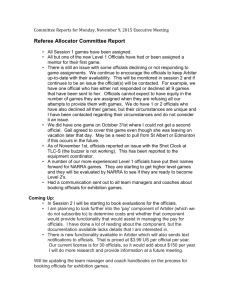P-192.615c-Liaison-with-Public-Officials
advertisement
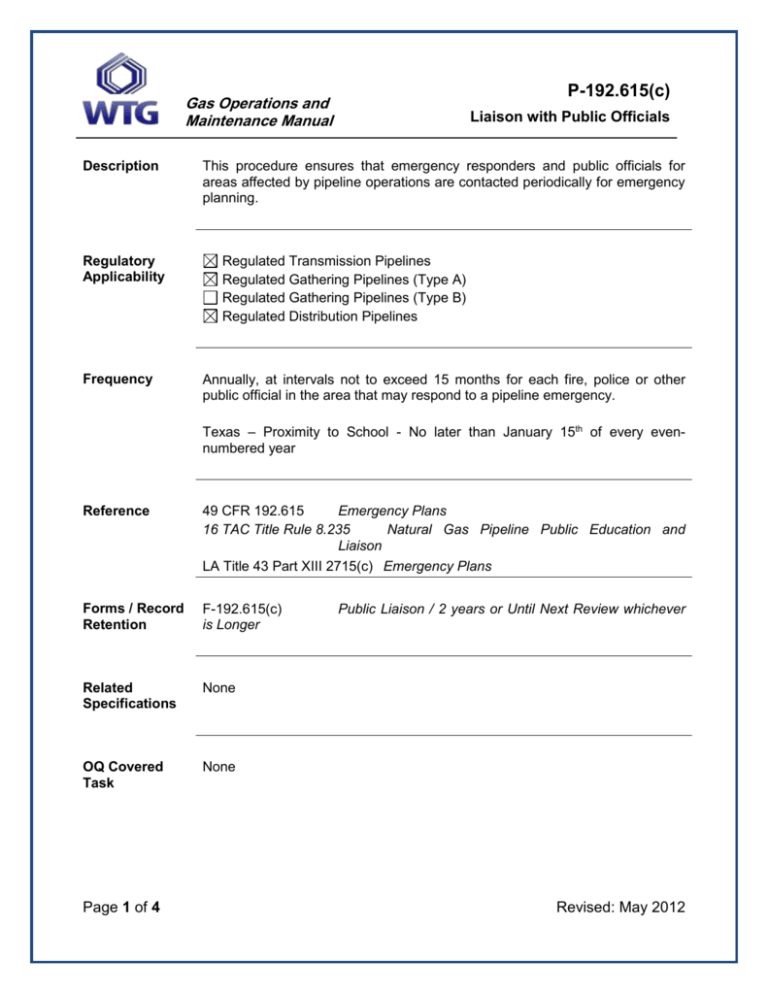
P-192.615(c) Gas Operations and Maintenance Manual Description Regulatory Applicability Frequency Liaison with Public Officials This procedure ensures that emergency responders and public officials for areas affected by pipeline operations are contacted periodically for emergency planning. Regulated Transmission Pipelines Regulated Gathering Pipelines (Type A) Regulated Gathering Pipelines (Type B) Regulated Distribution Pipelines Annually, at intervals not to exceed 15 months for each fire, police or other public official in the area that may respond to a pipeline emergency. Texas – Proximity to School - No later than January 15th of every evennumbered year Reference 49 CFR 192.615 Emergency Plans 16 TAC Title Rule 8.235 Natural Gas Pipeline Public Education and Liaison LA Title 43 Part XIII 2715(c) Emergency Plans Forms / Record Retention F-192.615(c) is Longer Related Specifications None OQ Covered Task None Page 1 of 4 Public Liaison / 2 years or Until Next Review whichever Revised: May 2012 Gas Operations and Maintenance Manual P-192.615(c) Liaison with Public Officials Procedure Steps 1. Contact appropriate fire, police, and other public officials who might have a role in response to a local pipeline emergency. Pipeline regulating agencies require liaison with groups who would normally be involved in emergency response in connection with pipeline operations. Those groups include local fire and police departments as well as other organizations that undertake emergency response functions. a) Fire Departments-Local municipal or volunteer fire departments will typically respond to pipeline emergencies. While their involvement may be limited to fighting secondary fires, they play an important role in the response. Lack of coordination between the pipeline operator and local fire officials may result in a dangerous situation. Similarly, the lack of pipeline emergency experience and knowledge of the particular pipeline system can present serious dangers for the firefighting team. Therefore, the pipeline operator will identify and contact each fire department along its line that might be called upon to respond to a fire. b) Police Departments-Local municipal police or county sheriff departments may also respond to a pipeline emergency. Their function will typically be crowd control and evacuation of persons in the vicinity of the emergency. Police agencies that might respond to emergencies along a pipeline should be identified and contacted. As with fire officials, lack of coordination between the pipeline operator and police organizations can endanger the police and others. c) Other Organizations-An investigation of the emergency response plan for an area may reveal that part or all of the fire fighting or policing functions are handled by local emergency planning committees or Civil Defense agencies. In such a case, the officials of these agencies should be identified and contacted for liaison. Similarly, in some rural areas, the city or county governments may be so small that firefighting or policing functions are handled by elected officials such as mayors, city council members, or county commissioners. If elected officials handle firefighting or policing functions, they will be contacted for liaison. Liaison will be performed with an official of each fire and police department whose area is traversed by the regulated pipeline. Where firefighting or policing functions are handled by other organizations (such as local emergency planning committees) or where, in less populated areas, these duties are handled by elected officials, they will be contacted. 2. Meeting objectives: a) Learn the responsibility and resources of each government organization that may respond to a pipeline emergency. (Document the anticipated response of the officials to a typical emergency and the resources they have available.) b) Acquaint the officials with the operator’s ability and plans for response to a pipeline emergency. (Explain how we would handle various types of emergencies.) c) Identify the types of pipeline emergencies where the operator will notify public officials. d) Plan how the operator and public officials can engage in mutual assistance to minimize hazards to life and property. (Note what contacts should be made in an emergency. Also Page 2 of 4 Revised: May 2012 Gas Operations and Maintenance Manual P-192.615(c) Liaison with Public Officials consider how and when we should coordinate a response with local emergency responders.) 3. Face-to-face meetings are preferred. When local officials are unavailable after repeated attempts to arrange a meeting, it is recommended that attempts at liaison be documented in a letter to the officials. A documentation letter will provide information required by the regulation such as a description of the operator's system and the operator’s plans in the event of a pipeline emergency. 4. Where a public official declines a face-to-face meeting, but will discuss, by phone, pipeline safety issues, it is recommended that a confirmation letter be sent discussing the points communicated and areas of cooperation identified in the phone conversation in addition to the operator’s capabilities and plans. 5. The documentation of any meeting with public officials should indicate that we provided the officials the following information about our system: a) Location of our regulated lines b) Materials carried in our pipelines c) Normal pressures in the pipelines d) General system design and shutdown procedures e) Emergency plans and resources 6. Document specific emergency contacts for the agency, the resources the agency may have at its disposal, and how the agency might respond to an emergency. Document conclusions reached as to the following: a) Type of events that might be classified as emergencies b) Situations where notice and coordination might be necessary c) Potential joint response appropriate for given emergency scenarios 7. A face-to-face meeting is recommended with each emergency responder who might be called upon to respond to a pipeline emergency. Where an emergency responder declines to meet, a letter is recommended from the operator to demonstrate compliance. Liaison contacts, whether by face-to-face meetings or other means, will be documented on Form F-192.615(c). Texas Intrastate Pipelines Designated representative will communicate and conduct liaison activities on an annual basis (at intervals not exceeding 15 months) with fire, police, and other appropriate public emergency response officials according to the provisions in the first part of this procedure. These activities will be conducted as follows: 1. An effort to conduct a community liaison meeting in person with the officials by one of the following methods must be done first: Page 3 of 4 mailing a written request for a meeting in person to the appropriate officials by certified mail, return receipt requested; Revised: May 2012 Gas Operations and Maintenance Manual P-192.615(c) Liaison with Public Officials sending a request for a meeting in person to the appropriate officials by facsimile transmission; or making one or more telephone calls or e-mail message transmissions to the appropriate officials to request a meeting in person. If a scheduled meeting does not take place, the operator or operator's representative shall make an effort to re-schedule the community liaison meeting in person with the officials using one of the methods above before proceeding to arrange a conference as described below. 2. If the operator or operator's representative cannot arrange a meeting in person after complying with #1 of this section, the operator or the operator's representative will make an effort to conduct community liaison activities by means of a telephone conference call with the officials by one of the following methods: mailing a written request for a telephone conference to the appropriate officials by certified mail, return receipt requested; sending a request for a telephone conference to the appropriate officials by facsimile transmission; or making one or more telephone calls or e-mail message transmissions to the appropriate officials to request a telephone conference. If a scheduled telephone conference call does not take place, the operator or operator's representative shall make an effort to re-schedule the community liaison telephone conference call with the officials using one of the methods above before proceeding to mail the liaison information as described below. 3. If the operator or the operator's representative has made the efforts required by #1 and #2 above but has not successfully arranged and held either a meeting in person or a telephone conference, the community liaison information required to be conveyed will be delivered by mailing the information by certified mail, return receipt requested. 4. In areas where any part of the natural gas pipeline facility is located within 1,000 feet of a public school building or public school recreational area West Texas Gas will notify the Commission by filing with the Safety Division, using the electronic version of the Form PS-87, no later than January 15th of every even-numbered year the following information: the name of the school; the street address of the school; and the identification (system name) of the pipeline. 5. Maintain records documenting compliance with the liaison activities. Records of attendance and acknowledgment of receipt by the emergency response officials will be retained for five years from the date of the event that is commemorated by the record. Records of certified mail and/or telephone transmissions will also be retained. Page 4 of 4 Revised: May 2012


